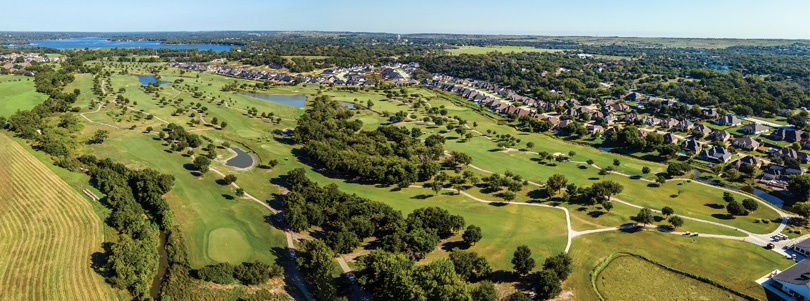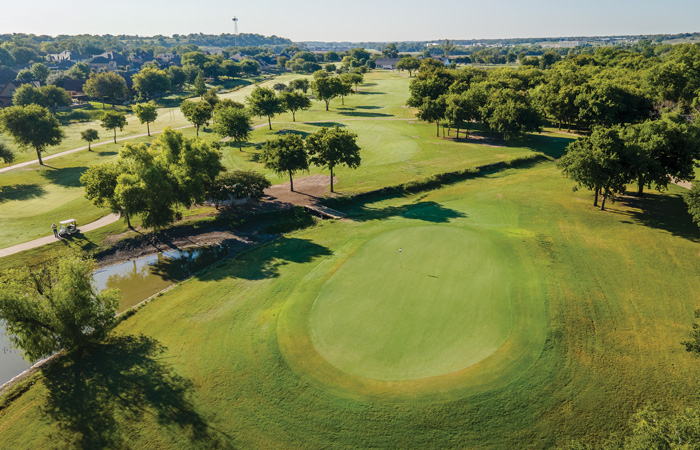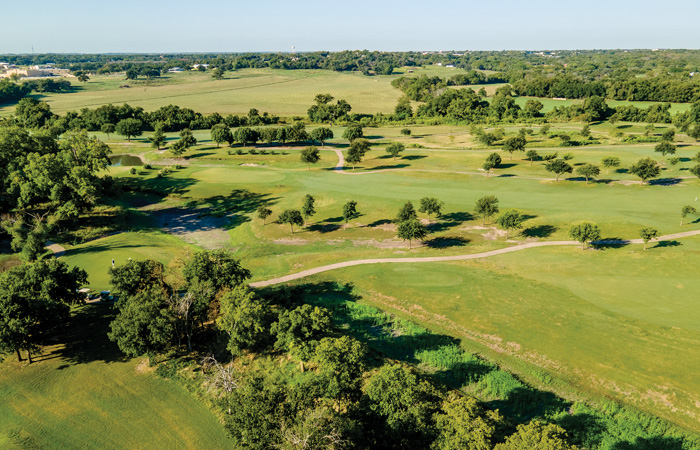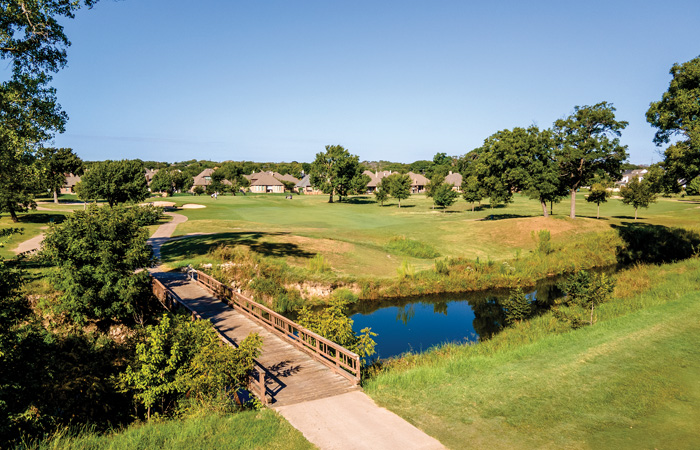Course Review – Oeste Ranch Golf Course

The west side of the Metroplex is one of the fastest growing areas in all of DFW. Cities and towns west of Fort Worth, such as Willow Park, Weatherford, Aledo, and even as far as Peaster and Brock, are seeing massive growth as families look for a quiet place to raise their children and enjoy some country living.
If you are on that side of town, then there is a daily fee course that offers a great country vibe and a fantastic overall layout. Oeste Ranch opened in 2002 and has since become a must-play at a great rate for those out west of Panther City.
For starters, before we dive into the course, there is a great restaurant and bar on the property called Seventy One, which offers a smorgasbord of breakfast, lunch and dinner items to enjoy before or after you tee it up. The pancake sandwich is a huge hit with the locals, and features a sausage patty, egg and cheese between two flapjacks, and comes with some sweet agave syrup. It is a perfect combo of salty and sweet and is sure to give you all the energy you require for 18 holes. A choose-your-own breakfast taco or a great breakfast burrito are also available if you want something quick before you hit the links.

For lunch or dinner, there are a multitude of salad, sandwich or burger options, but we started with some of the captain’s cheese curds, which are fried to a crunchy, oozy goodness and are perfect to share among the table. For your meal, I recommend the Jumpin’ Jack burger, which is a juicy patty topped with grilled jalapeños, pepper jack cheese, fried onions on toasted jalapeño sourdough with some salsa and a creamy, spicy Sriracha mayo. Should you want something with a Mexican flare, then the chicken fajita burrito or a big plate of the loaded nachos might be the play, both of which will scratch the Tex-Mex itch and leave you walking away satisfied.
A full bar is also available, with selections like domestic beers and wines, or something more exotic like the Rednexican, which is a refreshing cocktail made with reposado tequila, orange liqueur, fresh lime juice, pineapple juice and a splash of grenadine. The Oeste Ranch water is another signature drink, which is Topo Chico, doctored up with tequila or mezcal and garnished with lime and Tajin. It’s a refreshing beverage that will leaving you feeling no pain, even after a double-bogey or two. Oeste has one of the most interesting food and beverage programs at any daily in the area. There is something for everyone, and everything is delicious. It’s definitely not your standard beer and dog menu.
Oeste Ranch has one of the most loyal groups of players in recent memory, with plenty of the same players who tee it up sometimes on a daily basis. Upon arrival, I spoke with several gentlemen who said they played Oeste multiple times a week, usually at the same time. This can make getting a tee time a bit of a challenge, but where isn’t it a challenge these days? I guess my point is that Oeste has a great group of regulars, which usually means the course provides great service, good food, and an affordable, playable experience that brings players back again and again. That’s a good thing when you are looking for a great daily fee track to put a peg in the ground.

Oeste features four sets of tees, which allows skilled players to tip it out from just under 6,600 yards. The forward tees will run right at 5,000 yards, which is perfect for ladies or juniors looking to play something a bit more manageable. The tee markers themselves are unique, with cattle on them, adding to the rustic, Texas-to-the-bone feel. Bermuda greens are in solid shape and MASSIVE. Although the course itself isn’t tremendously long by today’s standards, the gigantic greens really put a premium on club selection and ball striking … and should you be having an off day with your irons, you might find yourself standing over multiple 50-plus-foot putts throughout the round.
Although straight away, the opening tee shot needs to be precise, as anything pulled left will find tree trouble, making reaching the green more difficult. A small burn winds across just short of the putting surface and can collect any shots that come up short. The opening green isn’t the largest on the property, but it is still a pretty good precursor for things to come. A precise iron is required for a stress-free two-putt par.
No. 2 is a hard dogleg around a pond that presents a distinct challenge early in the round. A driver might be too much club for the longer hitters, as any shots that bleed a bit right can run out of fairway. But, should you choose a three-metal or shorter club off the tee, you might not be able to cover the corner of the water. It’s an interesting tee shot. Should you find the fairway, the two-tiered green will offer another challenge. Be sure to check pin position and figure out your best miss before you pull the trigger on your approach shot.

No. 4 is the first of three par 5s on this par-71 layout. After a few tough holes, this offers players a chance at a potential birdie on the card. Playing at 501 yards from the tips, a good tee shot here will leave players just short of the Clear Fork of the Trinity River. A second shot of right at 200 yards remains, and longer hitters can attack the green in two. Execute and a four can find its way onto your scorecard.
No. 5 is the second of back-to-back par 5s. This one plays back in the opposite direction again over Clear Fork. At just 461 from the back tees, it is absolutely gettable, even for the non-bombers. A pair of deep bunkers guard the green short, so be mindful to draw enough club to cover them. A little long is better than a little short.
After a short par 4 at No. 6, comes back-to-back par 3s. I would have to do some research, but off the top of my head, I can’t come up with a course that features both back-to-back par 5s and back-to-back par 3s on the same nine. It is one of the things that makes this Steve Mrak design so unique and fun.
No. 7 is a 173-yarder, and some OB lurks if you go too far left, but, overall, there’s not much to worry about. Pick a club and let it fly. Find the green, and you could be looking at a stress-free par or maybe even a deuce.
No. 8 is a very interesting hole. It’s listed at 180 on the scorecard, but that’s all dependent on pin placement. If the pin is up front, you can take about 30 yards off that number; if the hole is cut deep, add about 20 yards. Basically, the green is so deep this one can play anywhere from 145 to near 200 yards. This makes for some variety from round to round, which is always fun. There is also some water than runs left of the hole, so be aware of it. The preferred miss here would be right, but with the longer, narrow green, anything that misses the green can be tough to get up-and-down.
The same creek that runs left of No. 8 also comes into play at No. 9. This is one of the narrowest fairways you will find at any daily fee in the area. Driver can be the play if you are feeling confident, but the short grass narrows a significant amount in the area where most players will land the big dog. The hole only plays around 340 yards, so it’s probably worth the risk of missing the narrow fairway in order to get a scoring club in-hand on the approach.

I think No. 10 at Oeste might be one of my favorite tee shots in DFW, especially if you are playing the tips. The back tees sit just a few feet from the large outdoor patio of Seventy One Bar & Grill, meaning as you put a tee in the ground, you will likely have an audience watching. It is one of the few tee shots where you genuinely get the feeling you are playing in a tournament. The activity around the clubhouse and on the patio can get your blood pressure up a bit as you hope you can find the clubface with spectators nearby. At 348 yards, if you can position a tee shot, you are left with an approach that is a bit uphill. There is more green than appears from the fairway, as the slightly elevated green only offers a sliver of the putting surface as a visual.
Without question, 11, 12 and 13 is the toughest three-hole stretch on the course. The trio measure 462, 405 and 458, respectively. Although they all play basically straight away, the wind conditions can make them easier or more difficult, depending on direction. Long hitters or those playing from shorter tees can make these holes a bit more palatable but know that if you aren’t very long off the tee, you might see a couple more mid- or long irons in hand over this stretch.
After the par-3 14th comes what I would consider to be one of the most challenging holes on the course. No. 15 plays back toward the Clear Fork portion of the Trinity, which you navigate earlier in the round. This par 4 plays as a slight dogleg left, and the fairway runs out at the river. Driver is too much club for longer players, but even a well-struck 3-wood that carries the large tree on the left can scramble out near the creek. This is a hole that being too aggressive can cost you, so a more conservative play might be your best bet. Keep your tee shot short of the creek and right of the large tree for position, and then hope to find the middle of the green on your approach. Par is absolutely a good score here, especially for those who prefer to work the ball left-to-right.
No. 16 is a short, but pretty, par 3 that is surrounded on all sides by trees that give it a natural amphitheater. It plays just 150 yards from the back tees and is one final straightforward shot before the tough finishing pair of holes.
The penultimate hole at Oeste is also the final par 5 of the day. This is the longest hole on the course and will play into the prevailing south wind most days. At 537 yards, this brut can play closer to 600 yards on breezy afternoons when the wind is howling across the property. Clear Fork runs right of the hole, but there is a bit more room right than it appears from the tee. A tee shot down the left side of the fairway is the play, as it will leave a clear shot into the green. Longer players can have a go at the green in two, but a layup and a precise wedge might be the better play if you are protecting a lead on one of your playing partners or trying to secure a par.
The closing hole at Oeste Ranch again brings the Clear Fork into play to the right. At just 392 yards, the smart play is a controlled iron or hybrid off the tee to take the big number out of play. It should be noted that when the prevailing winds are blowing from the south, this hole can also show some teeth. After the long par-5 17th, the shorter 18th can yield one last opportunity at a circle on the scorecard.

Conditions at Oeste Ranch are rock-solid, especially given their green fees are only around $55 during peak times. There were spots on a handful of greens that had clearly seen a little stress during the hot summer months, but the putting surfaces are so large, the pins were all cut in places where the stressed areas weren’t in play at all. Tees and bunkers are all well maintained, as well, and the clubhouse and large patio are clean and offer a great experience. Oeste Ranch is also one of the most walkable courses in the area. There is very little elevation change to speak of, making this not only simple to walk, but also keeps up pace of play as you can almost always track the ball well, making wayward shots easy to locate in a timely manner. It’s a great place to get some exercise walking nine or for junior players to build some stamina as they work on their game for tournament play.
If you have yet to make the trip to Oeste Ranch, I would recommend a visit. The overall value and hometown vibe make it a fun experience from top to bottom, and it’s not as far off the beaten path as you might think, being just about 35 minutes from the center of the Metroplex. A fun, scorable layout along with a friendly staff and a wallet-friendly rate make Oeste Ranch worth your time.



